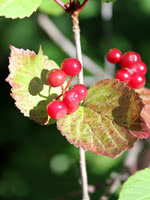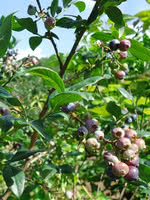Mon-Fri 9am - 5pm Mountain time
Lowbush Cranberry vs Northland Blueberry
Viburnum edule
Vaccinium corymbosum Northland
NOT AVAILABLE THIS SEASON - MIGHT RETURN
NOT AVAILABLE THIS SEASON - MIGHT RETURN
Lowbush Cranberry is a short, deciduous shrub native to North America. Its white flowers bear sour but edible fruit that ripens to a brilliant red in fall. Lowbush Cranberry's small size makes it suitable for urban use; buyers will also find it useful if trying to reclaim land back to its original species or when landscaping with native species in damp conditions.
Northland Blueberry is the hardiest of the half-high highbush blueberries. It's also the best looking. In fact, it is frequently planted as an ornamental. Northland Blueberry produces large quantities of medium-size berries that taste amazing but are on the softer side, which matters to some people.
You must also prune Northland Blueberry to maintain its health and productivity.
Note: Blueberries require very specific soil conditions. They need well-drained soil with a pH between 4.5 and 5.0. If the starting pH of your soil is between 5.1 and 6.2 you can lower it by adding sulfur. We recommend against planting blueberries in soil with a starting pH greater than 6.2. Please do your own research before buying any blueberry plants.

